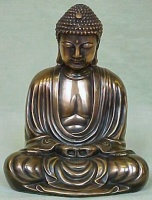Several good Buddhist-related stories are floating around the Internets these day. For some reason, journalists seem to be drawn to the Dharma (the NY Times, in particular, has published several excellent Buddhist stories recently).
The first item, from the Ole Grey Lady herself, is about a 55-year-old Buddhist monk, Michael Roach, who lives in the desert with his 35-year-old female partner, who is also a Buddhist and a teacher. The two are never more than 15 feet apart, but claim that their relationship remains chaste. Leaders in Roach’s Tibetan tradition, including the Dalai Lama, are reportedly not thrilled with the living arrangement. Monks, you see, are not supposed to have partners. As Tibetan Buddhist expert (and dad of Uma) Robert Thurman says, “He is doing this partnership thing and insisting on being a monk. It is superhuman. He says he is staying celibate, but people find it hard to believe.”
Secondly, as you may have heard, the Karmapa Lama is touring the U.S. His Holiness heads one of the four main Tibetan Buddhist sects (think of them like the mainline Protestant churches-they share a lot of beliefs, but differ somewhat in practices). If the Dalai Lama should somehow perish, the Karmapa Lama might become the face of Tibet, Time magazine says here. The Buddhist leader has an interesting personal story, including a daring escape from the Chinese, and a pretty large U.S. following, so it should be interesting to see how he is covered. The visit’s official blog is here.
Lastly, I turn to NYT columnist David Brooks, who wrote recently about a kind of “neural Buddhism,” as he calls it. As usual with Brooks, there are a couple of interesting ideas banging around in the column but they are so vaguely defined that it can be difficult to probe their deeper meanings. His basic point is that the more we know about the brain, the more difficult it will be to hold on to belief in a personal God. In its place, we may find “neural Buddhism,” which Brooks defines as:
First, the self is not a fixed entity but a dynamic process of relationships. Second, underneath the patina of different religions, people around the world have common moral intuitions. Third, people are equipped to experience the sacred, to have moments of elevated experience when they transcend boundaries and overflow with love. Fourth, God can best be conceived as the nature one experiences at those moments, the unknowable total of all there is.
If Brooks had looked into Buddhism a little more, he’d find that “neural Buddhism” is a bit redundant. Many, many Buddhists, including the Dalai Lama, consider themselves “scientists of the mind,” and nothing more. That said, I’m very very happy that people like Brooks are taking an interest in the Dharma.





